Royal Society Photo Contest Winners Capture Breathtaking Details Of Our Rapidly Changing World
From a swirling dance of mating mayflies to a lone clownfish swimming amongst a field of bone-white sea anemones, the top photos chosen for the Royal Society Publishing’s second annual nature photography contest showcase small but significant moments in a rapidly-changing world. While these images might not seem earth-shattering, their subtle subjects inspire new ways of looking at the natural world.
Special commendation. “Butterflies and caiman” by Mark Cowan.

Colourful butterflies gather on the head of this caiman to collect salt – an important mineral for their survival. This photo was taken while on a scientific expedition to the Amazon to study reptile and amphibian diversity. The expedition was led by researchers from the Herpetology Division at the University of Michigan and included participants from Peru and Australia. A number of minerals are a scarce resource throughout Amazonia and so this behaviour allows these invertebrates access to salt, much like the clay licks that are used by a variety of vertebrates. This particular phenomenon where butterflies and bees congregate on the heads and around the eyes of caimans and turtles has been documented before but what is unique here is the simultaneous number of butterfly species and the way in which each species is associated with its own kind.
More info: The Royal Society (h/t: smithsonianmag)
Overall winner and category winner: Behaviour. “Dancing with stars” by Imre Potyó.
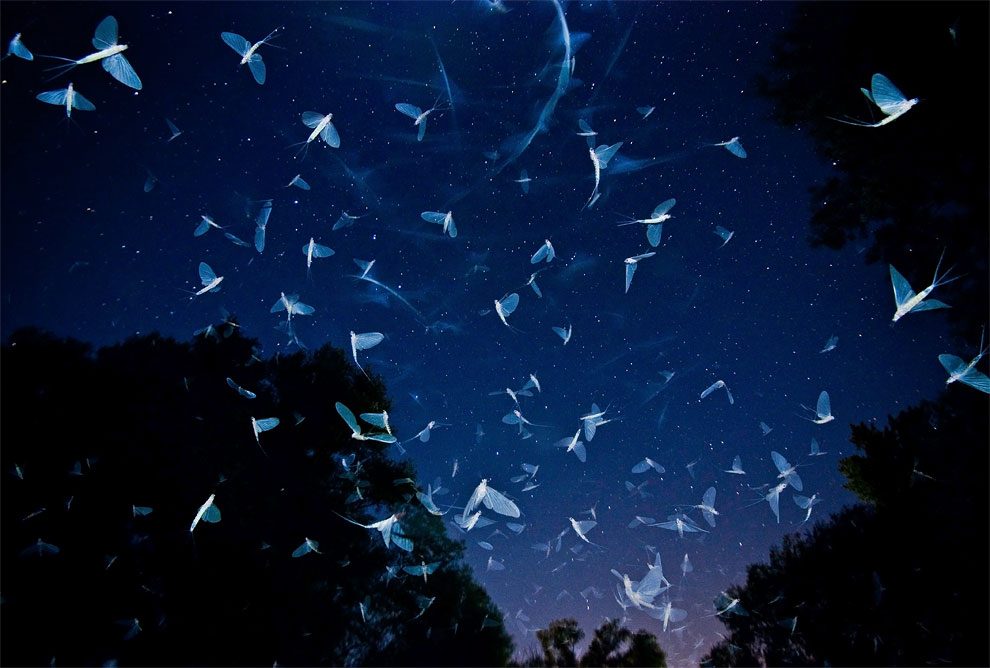
After a few decade’s absence, the Danube mayfly (Ephoron virgo) has returned to the river, probably due to the improving water quality. This photo captures the courtship dance of the short-lived adult mayflies on the bank of the Rába River, a tributary of the Danube in Hungary. The life of an adult mayfly is very short. They hatch from their juvenile aquatic form, mate in this fantastic spectacle, and then perish. The swarming dates are unpredictable and the dance might only last only a couple of hours. The mayflies start to swarm after sunset and do not leave the vicinity of the water surface during their courtship. At the beginning, females and males fly above the water surface where they copulate. After that the females begin their upstream-directed compensatory flight, which ends when they deposit their eggs onto the water surface. This shot captures the fantastic energy and chaos of the mayflies’ dance and the mood of the night time too.
Category winner: Ecology and Environmental Science. “In a world without colour” by Tane Sinclair-Taylor.
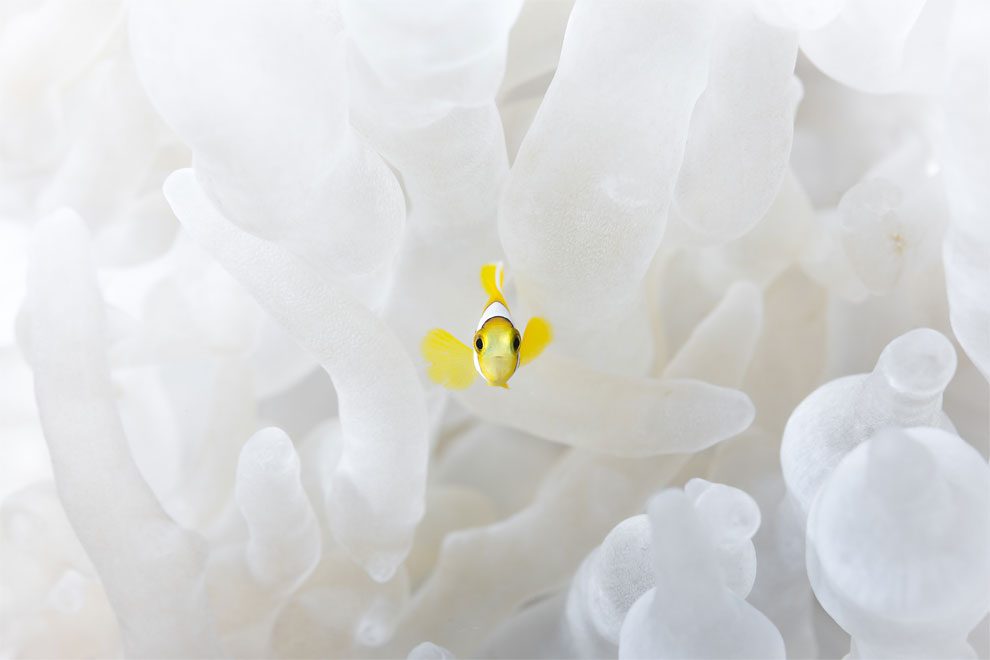
A solitary juvenile clown fish (Amphiprion bicinctus) stands out in its colourless habitat among the tentacles of the sea anemone Entacmaea quadricolor. The once colourful sea anemone has lost its colour following a global beaching event. Elevated sea temperatures have caused the loss of an algae (zooxanthellae – Symbiodinium) which usually lives symbiotically in the anemone’s tissue. Along with the loss of photosynthetic pigments, the absence of algae makes the anemone appear pale and ‘bleached’. This photo was shot during a research cruise documenting devastating post-bleaching coral mortality in the Farasan Banks in the Red Sea, Saudi Arabia. The lone fish seems like a timely analogy for a generation that may grow up in a bleak future without the colourful and diverse coral reefs that we have today.
Category winner: Micro-imaging. “In balance” by María Carbajo Sánchez.
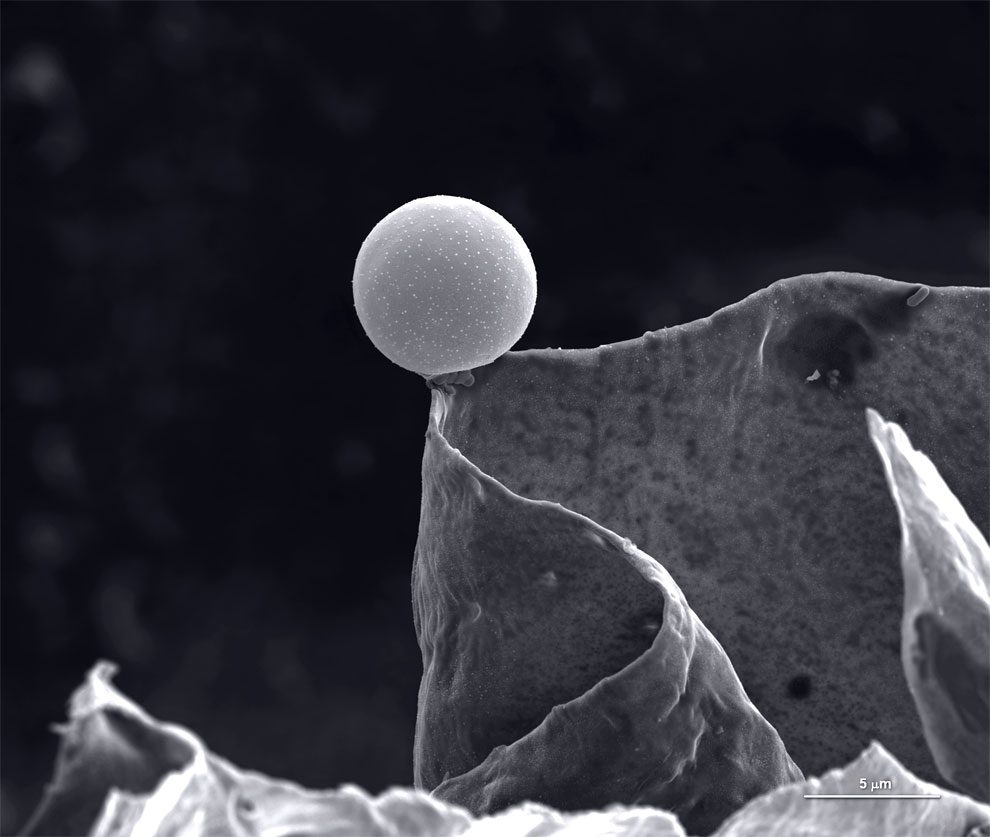
Electron microscopy reveals the alien landscape of the surface of an activated carbon grain. It’s a lot like photography but instead of light, electron microscopes use a beam of electrons to make an image. This image is magnified 5000 times to see the structures of the surface of an activated carbon grain. Just as carbon is used to filter water it can be used in waste treatment for power plants. Activated carbon is prepared from biomass that is rich in carbon – wood, nutshells, olive pits. This piece of activated carbon was prepared from nutshells by a research team looking at using biomass waste for energy production. It may have been the roughness and variation in the surface of the nutshell that caused the curious and surprising images we obtained using the electron microscope, including this one of a microsphere in perfect balance.
Category winner: Evolutionary Biology. “Departing eagle ray” by Nick Robertson-Brown.
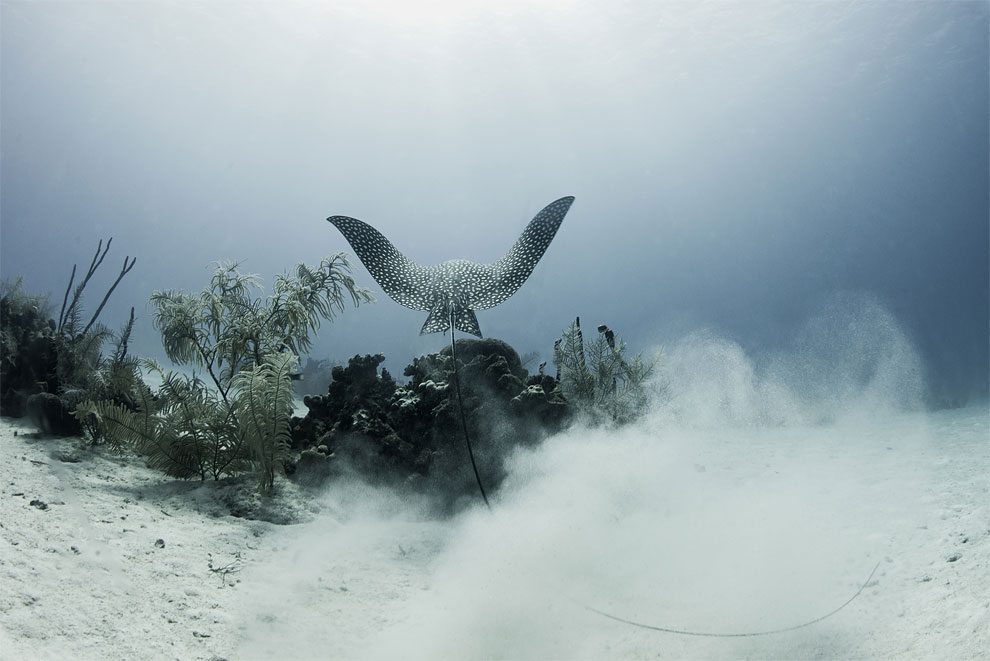
An eagle ray swims over the reef with its prey, having dug it up from the sandy sea-bed. Eagle rays have evolved very long tails but this is the longest that I have ever seen. From a functional morphology perspective, when considering structure-function relationships, this image has an interesting tension. On the one hand, the image makes familiar sense: the ray in water flexes its fins much like a bird in air, hinting the possibility of convergence. On the other hand, the image is an utter enigma: what could possibly be the function of this unusually long tail?
Runner up: Behaviour. “In search of food” by Jonathan Diaz-Marba.
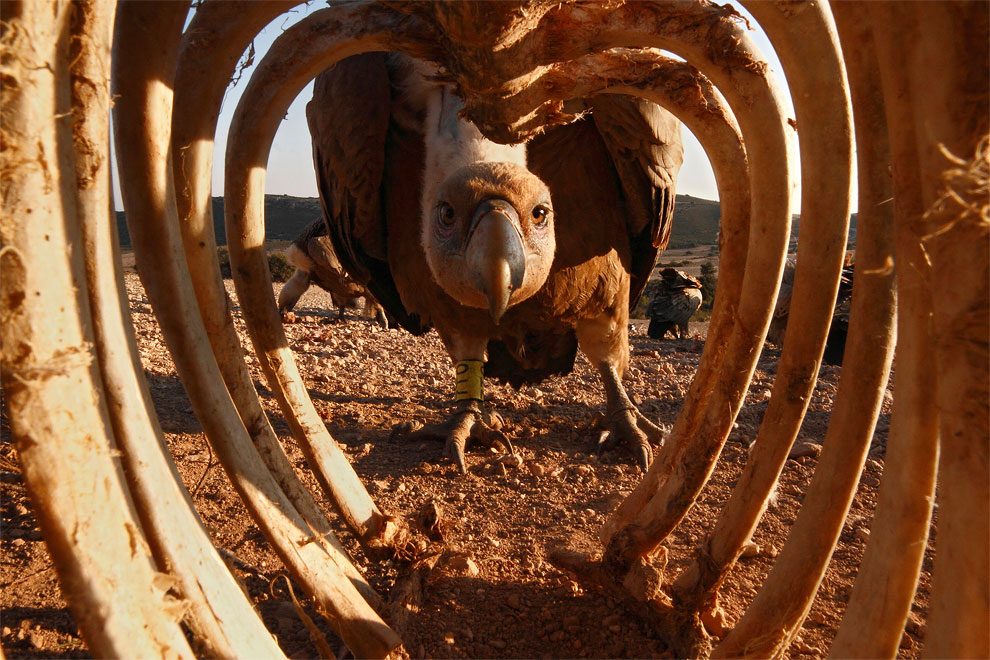
I watched feeding griffon vultures searching inside the ribcage of a large mammal. I tried my luck using the camera inside the carcass, shooting from a hide with the help of a trigger wire 20 meters long. My fear was that these huge birds could vandalize the expensive photographic equipment, but I had to take the risk. I realized that the use of a flash to illuminate the inside of the rib cage was not possible because the space was very small and the vultures distrusted much of the equipment. Instead everything was illuminated with natural light at dawn. At this time and at this angle of incidence, light seeped between the ribs of the animal, illuminating the interior. The birds nest in colonies on cliffs that are undisturbed by humans and fly over huge open areas searching for food. It was therefore important to choose the time and place carefully – in particular, I chose an area with many magpies, whose presence gives the vultures a good cue of where to feed.
Runner up: Ecology and Environmental Science. “Les artistes” by Tegwen Gadais.
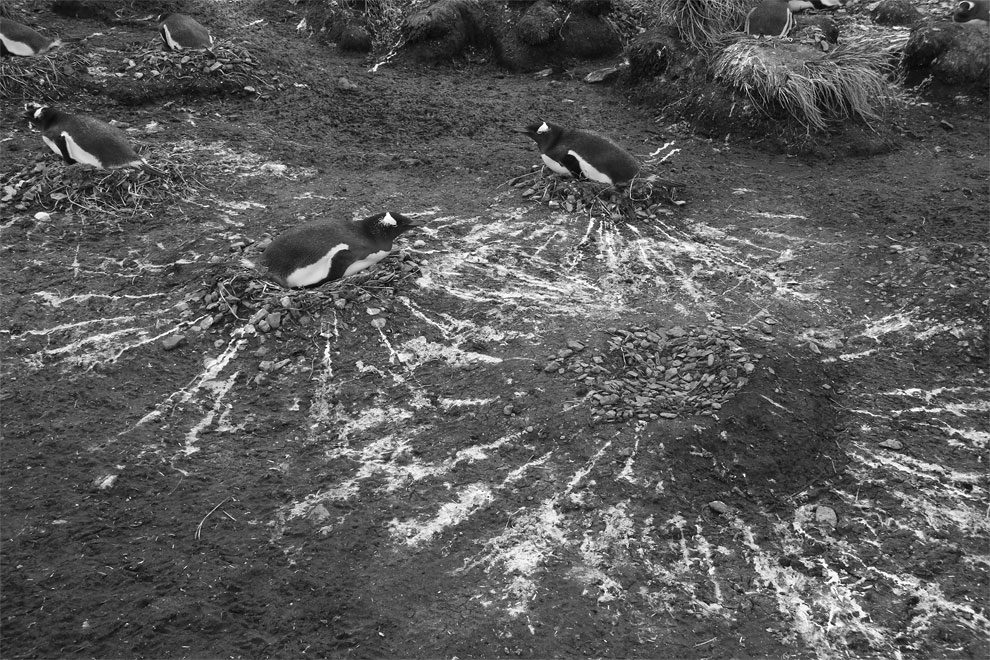
This photograph was taken on Royal Bay located on the island of South Georgia, where I observed Gentoo penguins seemingly “decorating” their nest with guano – their excrement. Parents will build up a nest of stones, sticks, grass, feathers or any other suitable material that is available around them, and be positioned where they can access the ocean. Once the eggs have been laid each parent will take turns incubating them, relieving themselves by lifting their tails away from the nest and creating the long streaks seen in the picture. Incubation lasts for over a month and hatched chicks will remain in the nests for several weeks before moving to a communal crèche where they are fed for another two months. Although the streaks provide a striking image, the amount of guano and other waste accumulated means that the penguins will need to change their nesting ground each season.
Runner up: Micro-imaging. “The spiralled snake axis” by Tyler Square.

During early growth and development, most vertebrate animals look quite similar. Here, in this image of a one-day post-oviposition African house snake (Boaedon fuliginosus), we see many features that tie all vertebrates together: pharyngeal arches surrounding the mouth and throat (with gill slits between them), muscle segments (called somites) which will eventually contribute to the spine and musculature, and a chambered heart connected to a closed circulatory system to move oxygen and nutrients to tissues. During and after these stages, the novelties specific to a species or lineage begin to develop – here the 5mm long elongated body of the snake develops as a spiral to fit inside the egg.
Runner up: Evolutionary Biology. “Polychaetous worm with engine and wagons” by Fredrik Pleijel.
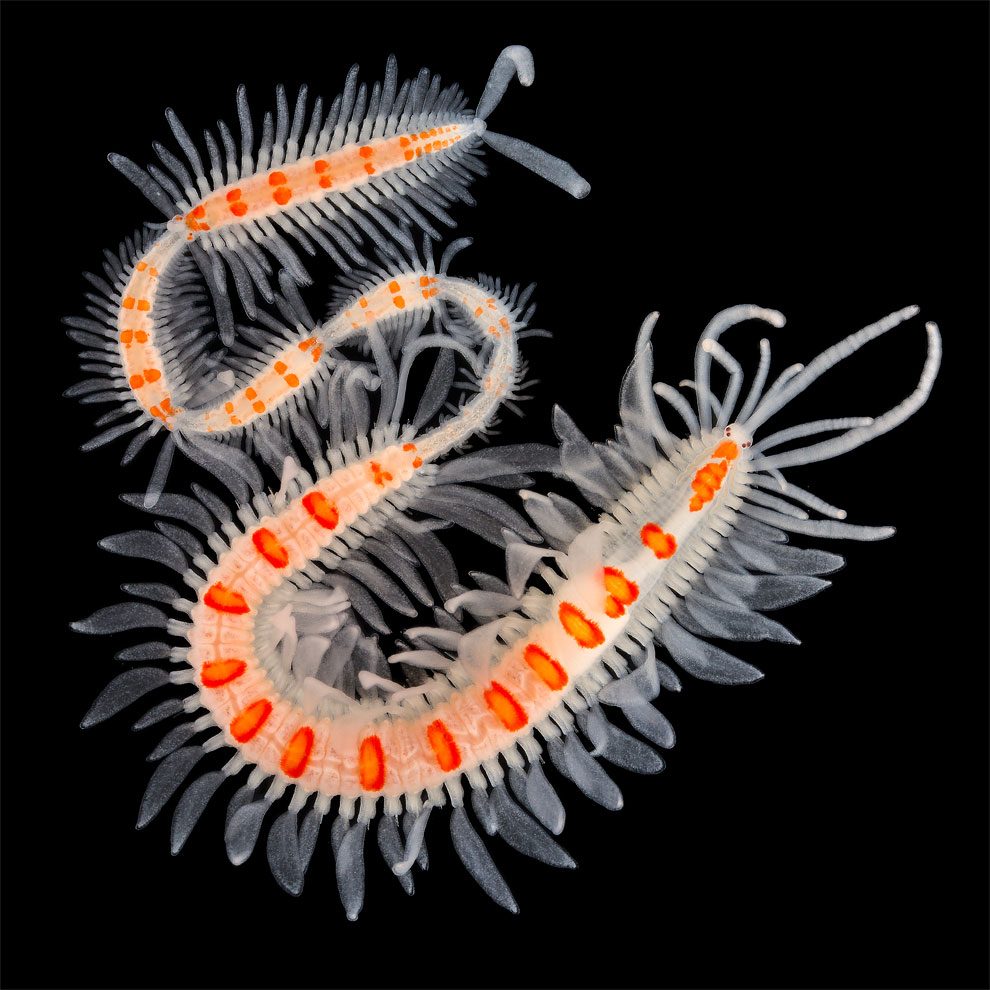
This trainworm (Myrianida pinnigera), which is 35mm from head to tail, lives on the sea floor. Its front end, the trainworm’s engine, is followed by a row of carriages called ‘stolons’ that increase in size towards the worm’s tail end. The carriages are the worm’s swimming sexual organs. When the trainworm is mature, the last carriage in the train lets go and detaches. It swims up the water column to reproduce. The carriages, unlike the engine, all lack a gut and are full of either sperm or eggs. In the water column the well-developed sensory organs seek out another stolon to mate with. After mating the male stolons die. The females survive a short time to shelter the embryos, which are carried in their bellies. Meanwhile, the trainworm on the sea floor continues to produce stolon carriages.
Special commendation (Publisher’s choice). “Speeding divergence” by Prasenjeet Yadav
 .
.
The Superb fan-throated lizard (Sarada superba) is a native to a small high-elevation, iron-rich and humid, plateau in the northern Western Ghats of India. About two decades ago, a large part of this plateau was converted into one of the largest wind farms in Asia. This has resulted in drastic changes in the ecology of this charismatic lizard species. Researchers from Dr Thaker’s lab at the Centre for Ecological Sciences, Bangalore have found that wind-farms result in a decrease in raptor densities which in turn results in an increase lizard abundances. Interestingly, they also find that the lower levels of predation in wind-farms also result in a change in the physiology, morphology and behaviour of the lizards, seemingly accelerating the process of trait divergence in less than two decades.
Special commendation. “Carbon nanotube jellyfish” by Clare Collins.

Seemingly a swarm of jellyfish, this image was actually created using carbon nanotubes grown in a pillar formation. The metal disks that make up the jellyfish bodies are made by ‘sputtering’ charged aluminium and iron ions onto a surface to deposit a thin film of the metals. The carbon nanotubes grow from this thin disk. The disks are 5 micrometers in diameter- 5 1/1000ths of a millimetre – and are 10 micrometers apart. If you zoomed out of the image, you would be able to see that they make up part of a 2 mm x 2 mm pattern across the surface of a silicon chip. I research carbon nanotubes to study the emission of electrons, called the field emission, from a number of different configurations. The applications for field emission could be for displays or as X-ray sources.
Special commendation. “Fubuki (snow storm)” by Alexandre Bonnefoy.
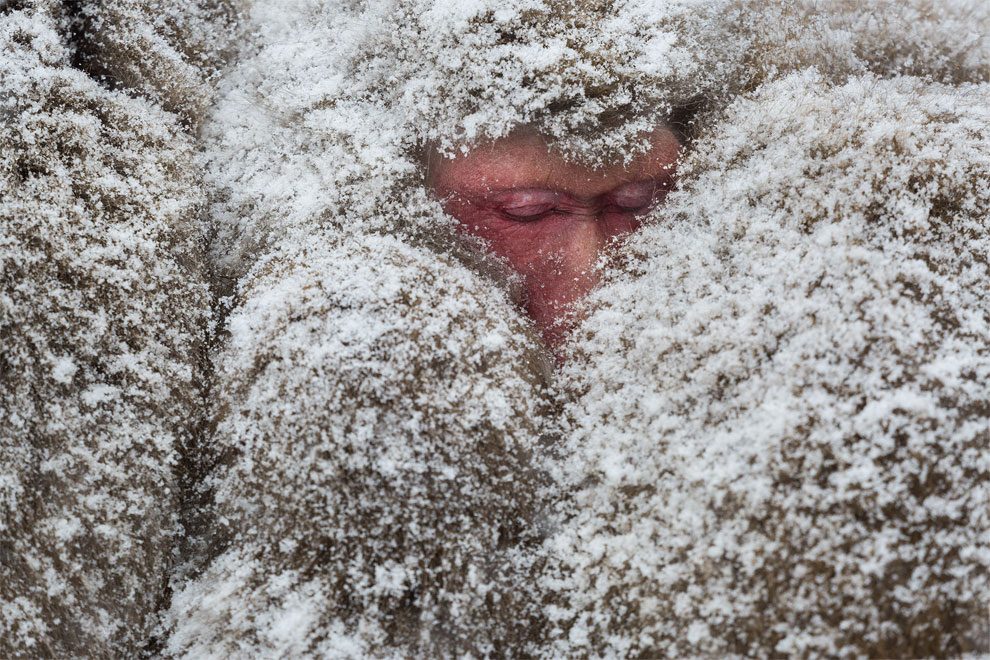
Japanese macaques are the most northern-living, non-human primates and survive in the coldest conditions. I followed these primates during autumn, winter and spring all over Japan to document their behaviours. During winter they huddle to keep warm. When they huddle in these small groups it is called in Japanese “saru-dango”, saru means “monkey” and dango is a skewer of Japanese sweet dumpling made from rice flour. These groups are composed only of members of the same family. This behaviour is not observed everywhere in Japan, but only in few groups. It’s a cultural behaviour peculiar to the monkeys in Shodoshima and in Nagano, where this photo was taken, where there is a hot spring which the monkeys bathe in. Monkeys in other parts of Japan have their own cultural behaviours, they wash potatoes on the Kojima Island in the south, play with stones in Arashiyama and even ride deer in Yakushima island.